Excerpts from Jim Conrad's
Naturalist Newsletter
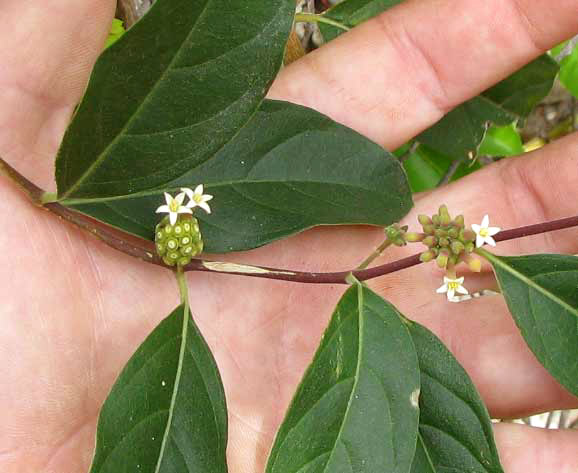
from the January 2, 2011 Newsletter issued from Hacienda Chichen Resort beside Chichén Itzá Ruins, central Yucatán, MÉXICO; limestone bedrock, elevation ~39m (~128ft), ~N20.676°, ~W88.569°
MOUSE'S PINEAPPLE
Twining unobtrusively with other vines cascading over a stone wall in Pisté was the delicate species shown above.
You can see why one of the many English names used for the vine is Mouse's Pineapple. The pineapple is formed by the close clustering of numerous maturing inferior flower ovaries. Inferior ovaries are those from which the calyx's sepals, the corolla and the stamens arise above the ovary, not at the ovary's base, in which case it would be a superior ovary. We have a diagram showing the two conditions.
In the picture at the top of the page, at the left all but two corollas have fallen off the cluster of ovaries, while at the right a cluster's first two corollas have opened, the other ovaries still bearing unopened corollas. A close-up showing better how the corollas arise atop the ovaries is below:
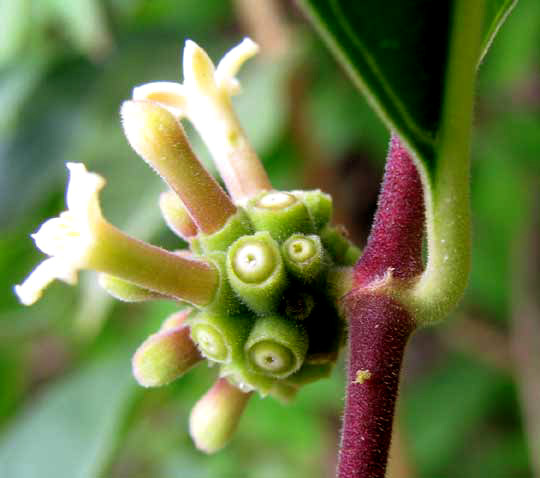
The last picture also shows a low, sharp-pointed, triangular stipule connecting the base of a leaf petiole and the flower cluster. When you see the combination of inferior ovary with conspicuous stipules, automatically you should think "the Coffee or Gardenia Family, the Rubiaceae." In the New World tropics the Coffee Family is a big one, but also one of the easiest to identify families because those two field marks are so determinative.
Mouse's Pineapple, also called Redgal, Yellowroot and other names, is MORINDA ROYOC. It's distributed from southern Florida, Mexico and the Caribbean south through Central America to northern South America, especially on limestone. Though it's a native wild plant, I see it mostly in towns on stone walls, where it can grow 20 feet long (6m).
You might recognize that genus name, Morinda, as the same genus in which Nonis are found. Nonis are small trees much planted in the Yucatan because of the medicinal value of their fruits. Noni is described at www.backyardnature.net/yucatan/noni.htm.
Noni's flowers and fruits are very similar to Mouse's Pineapple's, but much larger. Mouse's Pineapple's fruits also are variously used medicinally, as well as an aphrodisiac, and as a source of yellow, orange, or red dyes. Martinez's Las Plantas Medicinales de México says that the plant is useful as a digestive tonic and against the jaundice.
At one time it was thought that plants from the Yucatán were a distinct species and were given the binomial Morinda yucatanensis. However, now Yucatán's plants have been lumped into the preexisting Morinda royoc.
from the June 12, 2016 Newsletter issued from Hacienda Chichen Resort beside Chichén Itzá Ruins, central Yucatán MÉXICO
MOUSE'S PINEAPPLES IN JUNE
Nowadays along trails through the woods Mouse's Pineapples' "pineapples" are still immature, but they're much larger than on our earlier January vine. You can see some below:
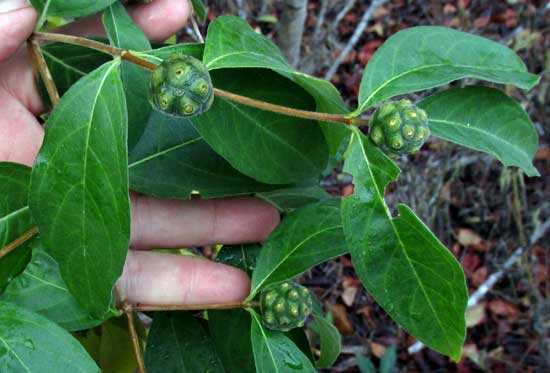
A close-up of a single fruit is shown below:
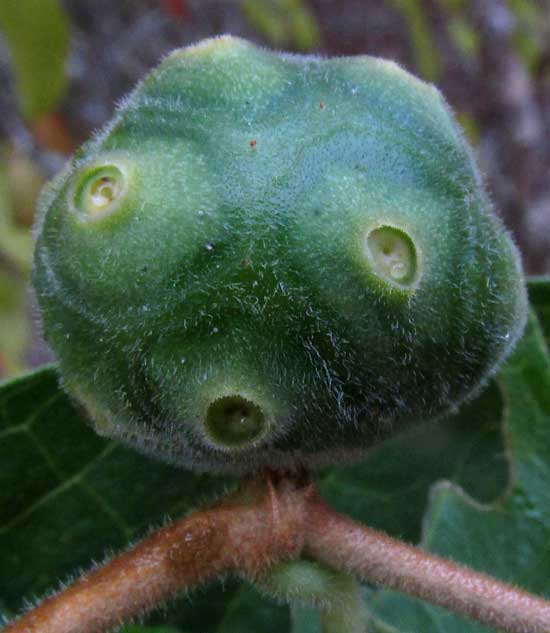
Each crater-like hole in the fruit is the scar from where the blossom fell off. Therefore, what's shown in the above picture is a "multiple fruit" consisting of several to many crammed-together "simple fruits," each simple fruit forming from the ovary of one flower. In the above picture you can see where individual ovaries have fused together at lines between the craters. Mulberries, Osage Oranges, pineapples and figs are examples of other multiple fruits, which are to be distinguished from "aggregate fruits," which look like multiple fruits, except that each bump on a multiple fruit develops from one of several separate ovaries or pistils in a single flower -- one flower with several pistils.
I was tempted to wait to take these photos until the fruits matured. However, we've noted that Mouse's Pineapple is closely related to the Noni -- famous for its medicinal value -- profiled at www.backyardnature.net/yucatan/noni.htm
And Noni fruits are edible. You might remember our picture of a Gray Fox carrying a Noni fruit in his mouth, at www.backyardnature.net/n/11/110717fx.jpg
I was afraid I'd never see a ripe Mouse's Pineapple, but if I do, I'll show it to you later.
from the May 31, 2018 Newsletter issued from Rancho Regenesis in the woods ±4kms west of Ek Balam Ruins; elevation ~40m (~130 ft), N~20.876°, W~88.170°, central Yucatán, MÉXICO
MOUSE'S PINEAPPLE FRUITS MATURING
This week a vine turned up bearing nearly mature fruits, shown below:
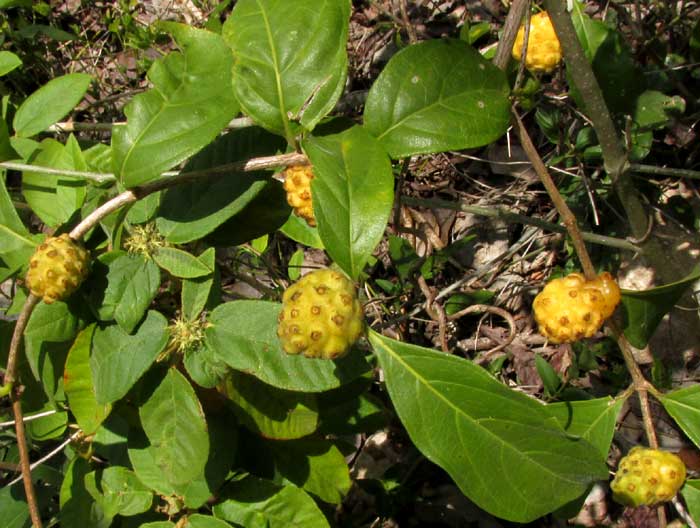
All the fruits except the one at the image's center-right, despite their yellowish color, were still much too hard to eat. That one on the right was soft enough to squish. I asked our Maya workers if they ate the fruits, and they don't. However, two workers reported that during those seasons when chickens and turkeys develop warts around their eyes, when the fruits are chopped up and fed to the fowls, the warts disappear. One said that the fruit juice is good for boils.